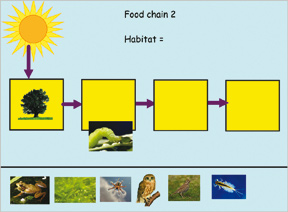Teacher Mediation

As will be clear, the research reported here considers how teachers integrated children's semi-autonomous use of the IWB into their science lessons. In so doing the teacher would sometimes intervene directly with the groups working at the IWB, to assist their thinking ,move them on or help with technical issues. However, the teachers also had a 'vicarious presence' that was evident in the group interactions at the board; we suggest that the teacher remotely mediates the activity of the pupils at the board in two specific and interlinked ways. The first of these is concerned with the ways in which the pupils appropriate and use introduced rules and procedures – in this case in relation to group talk. In our research classrooms, the emphasis on classroom rules for talk seemed to create, in the minds of pupils working in groups at the IWB, a collective sense of appropriate ways in which to conduct learning conversations. We observed them working with these rules, interpreting them for the needs of their situation at the IWB, implicitly and explicitly remembering the emphasis placed upon them by the teacher. Prior to full internalization of this support structure - and the confident, autonomous use of 'exploratory talk' - they were learning to become learners of the sort that seems to be expected by the teacher. Importantly, we'd suggest that it is the collective, distributed awareness of this vicarious presence of the teacher in the minds of the pupils that enables groups to operate effectively, collectively mediating one another's learning behaviour.
The second way in which the vicarious presence of the teacher is evident in our research classrooms is in the ways in which the teacher uses the task structure to guide and mediate the pupils' actions, enabling them to interpret and act upon the teacher's intentions for the task. Much research in this area has focused on the mediational effects ascribed to ICT tools in the context of computer-supported collaborative learning, where software is usually specifically designed to guide and mediate collaborative learning at the computer in particular ways.
By contrast, in our research the standard IWB interface allows the creation of teacher constructed environments so that the teacher's vicarious presence is evident in the technology. Using the standard software on the IWB, and the occasional integration of internet or hardware resources, the teachers in our research classrooms devised learning activities that might serve to mediate the pupils' collaborative interaction and learning. They were thus using technological tools that are not designed specifically to support collaboration, but which rather presented possibilities to teachers and pupils for developing science learning. This is important, as in the project we hoped to see how teachers might express the functionality of the standard IWB software as affordances for collaborative learning in their science lessons, scaffolding activities through the structure of particular activities and through the ways in which they enabled interactivity within and between IWB pages.
